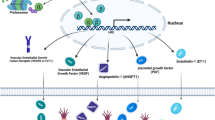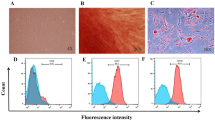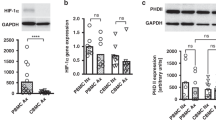Abstract
Study design:
Animal model of compressive spinal cord injury (SCI), reverse transcription-polymerase chain reaction (RT-PCR), in situ hybridization (ISH), immunohistochemistry (IHC) and enzymehistochemistry (EHC) were used to test the hypothesis that hypoxia-inducible factor-1α (HIF-1α) and the target genes activated by HIF-1α are involved in cell hypoxia tolerance and tissue vascularity to help injured tissue to go through the stress disease.
Objective:
To determine whether HIF-1α and its target genes associated with hypoxia tolerance and neovascularization take part in the pathophysiological procedure of SCI in rats.
Setting:
Yunnan University, China.
Methods:
Random-bred adult male Sprague–Dawley (SD) rats weighing 250±50 g were prepared for compressive SCI models. After receiving compressive injury at T10, rats were sacrificed at different times from 6 h to 1 week after injury. The injured cords were removed, and HIF-1α and its target genes were assayed by RT-PCR, ISH, IHC and EHC. The data were statistically analyzed.
Results:
An increase in HIF-1α mRNA expression was observed 12 h postinjury, reached a maximum at 3 days, and reduced gradually thereafter. HIF-1α protein expressed earlier than HIF-1α mRNA. Additionally, two glycolytic enzymes and vascular endothelial growth factor (VEGF), which are regulated by HIF-1α, also increased after an interval postinjury, and their expression patterns shared a same trend with that of HIF-1α protein.
Conclusion:
The findings suggested that the most important hypoxic regulatory factor HIF-1α was upregulated in involved cells by activating the transcription and increasing protein stability, and subsequently activated the expression of HIF-1α target genes, including glycolytic enzymes and VEGF in SCI. Combined with the pathologic observation, it suggested that overexpression of HIF-1α and its target genes might take part in hypoxia tolerance and vascularity of the injured spinal cord.
Similar content being viewed by others
Log in or create a free account to read this content
Gain free access to this article, as well as selected content from this journal and more on nature.com
or
References
Tator C, Fehlings M . Review of the secondary injury theory of acute spinal cord trauma with emphasis on vascular mechanisms. J Neurosurg 1991; 75: 15–26.
Semenza G, Wand G . A nuclear factor induced by hypoxia via de novo protein synthesis binds to the human erythropoietin gene enhancer at a site required for transcriptional activation. Mol Cell Biol 1992; 12: 5447–5454.
Zhong H, De Marzo A, Erik L . Overexpression of hypoxia-inducible factor 1α in common human cancers and their metastases. Cancer Res 1999; 59: 5830–5835.
Lee S et al. Early expression of angiogenesis factors in acute myocardial ischemia and infarction. N Engl J Med 2000; 342: 626–633.
Elson D et al. Coordinate up-regulation of hypoxia inducible factor (HIF-1α) and HIF-1α target genes during multi-stage epidermal carcinogenesis and wound healing. Cancer Res 2000; 60: 6189–6195.
Wang G et al. Hypoxia-inducible factor 1 is a basic-helix–loop–helix-PAS heterodimer regulated by cellular O2 tension. Proc Natl Acad Sci USA 1995; 92: 5510–5514.
Frank J et al. Hypoxic regulation of inducible nitric oxide synthase via hypoxia inducible factor-1 in cardiac myocytes. Circ Res 2000; 86: 319–325.
Semenza G et al. Hypoxia response elements in the aldolase A, enolase 1, and lactate dehydrogenase A gene promoters contain essential binding sites for hypoxia-inducible factor 1. J Biol Chem 1996; 271: 32529–32537.
Hideo K et al. Hypoxia response element of the human vascular endothelial growth factor gene mediates transcriptional regulation by nitric oxide: control of hypoxia-inducible factor-1 activity by nitric oxide. Blood 2000; 95: 189–197.
Ilan S et al. Stabilization of vascular endothelial growth factor mRNA by hypoxia and hypoglycemia and coregulation with other ischemia-induced genes. Mol Cell Biol 1995; 15: 5363–5368.
Bergeron M et al. Induction of hypoxia-inducible factor-1 (HIF-1) and its target genes following focal ischaemia in rat brain. Eur J Neurosci 1999; 11: 4159–4170.
Bergeron M et al. Role of hypoxia-inducible factor-1 in hypoxia-induced ischemic tolerance in neonatal rat brain. Ann Neurol 2000; 48: 285–296.
Marti H et al. Hypoxia-induced vascular endothelial growth factor expression precedes neovascularization after cerebral ischemia. Am J Pathol 2000; 156: 965–976.
Nordal RA et al. Hypoxia and hypoxia-inducible factor-1 target genes in central nervous system radiation injury: a role for vascular endothelial growth factor. Clin Cancer Res 2004; 10: 3342–3353.
Ju Y, He M, Mao B . Sequential changes of hypoxia-inducible factor 1 alpha in experimental spinal cord injury and its significance. Chin J Traumatol 2002; 5: 103–106.
Taoka Y et al. Reduction of spinal cord injury by administration of iloprost, a stable prostacyclin analog. J Neurosurg 1997; 86: 1007–1011.
Zhu Fengchun . The new method of enzymehistochemisty. In: The Chinese People Press 1st edn. Beijing 1980 pp 300–302.
Semenza G et al. Transcriptional regulation of genes encoding glycolytic enzymes by hypoxia-inducible factors 1. J Biol Chen 1994; 269: 23757–23763.
Sutter CH, Laughner E, Semenza G . Hypoxia-inducible factor 1alpha protein expression is controlled by oxygen-regulated ubiquitination that is disrupted by deletions and missense mutations. Proc Natl Acad Sci USA 2000; 97: 4748–4753.
Tator C, Izumi K . Vascular mechanisms in the pathophysiology of human spinal cord injury. J Neurosurg 1997; 86: 483–492.
Izumi K, Tator C, Lea PJ . Three-dimensional analysis of the vascular system in the rat spinal cord with scanning electron microscopy of vascular corrosion casts. Part 2: acute spinal cord injury. Neurosurgery 1993; 33: 285–292.
Anthes D, Elizabeth T, Tator C . Ultrastructural evidence for arteriolar vasospasm after spinal cord trauma. Neurosurgery 1996; 39: 804–814.
Eugene D, Brain J, James T . Coordinate regulation of glycolysis by hopoxia in mammalian cells. J Cell Physiol 1984; 118: 287–290.
Zhang ZY, Lloyd G . Experimental spinal cord injury: Wallerian degeneration in the dorsal column is followed by revascularization, glial proliferation, and nerve regeneration. Exp Neurol 1997; 147: 159–171.
Marti H, Risau W . Systemic hypoxia changes the organ-specific distribution of vascular endothlia growth factor and its receptors. Proc Natl Acad Sci USA 1998; 95: 15809–15814.
Acknowledgements
This research was supported by the Department of Science and Technology of Yunnan Province (Grant No. 2003C0010Q) and Yunnan University (Grant No. 2002Q006SM, 2001KF-13).
Author information
Authors and Affiliations
Rights and permissions
About this article
Cite this article
Xiaowei, H., Ninghui, Z., Wei, X. et al. The experimental study of hypoxia-inducible factor-1α and its target genes in spinal cord injury. Spinal Cord 44, 35–43 (2006). https://doi.org/10.1038/sj.sc.3101813
Published:
Issue date:
DOI: https://doi.org/10.1038/sj.sc.3101813
Keywords
This article is cited by
-
Heme oxygenase-1 promotes neuron survival through down-regulation of neuronal NLRP1 expression after spinal cord injury
Journal of Neuroinflammation (2016)
-
Axotomy-induced HIF-serotonin signalling axis promotes axon regeneration in C. elegans
Nature Communications (2016)
-
Analysis of the potential pathways and target genes in spinal cord injury using bioinformatics methods
Genes & Genomics (2016)
-
Transient ischemia induces massive nuclear accumulation of SUMO2/3-conjugated proteins in spinal cord neurons
Spinal Cord (2013)
-
Hypoxia-specific GM-CSF-overexpressing neural stem cells improve graft survival and functional recovery in spinal cord injury
Gene Therapy (2012)



